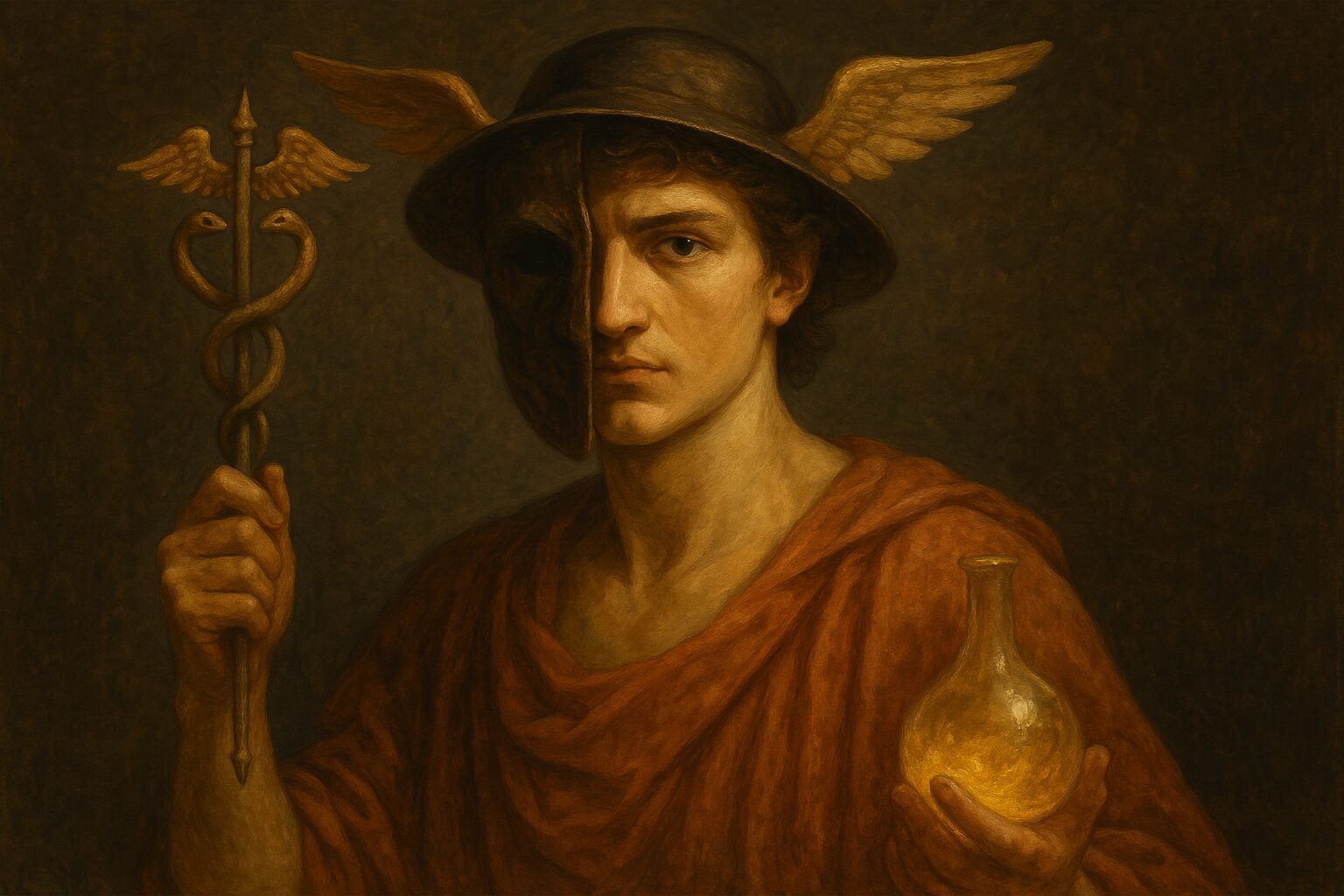In the dim corridors of myth and meaning, one figure moves with quicksilver grace—neither god nor devil, neither savior nor destroyer, yet something of all. Hermes, the Greek god of messages, thresholds, and trade, wears many masks. And it is precisely his slipperiness that makes him the perfect icon of a world in flux. But there is more to Hermes than winged sandals and stolen cattle. Beneath his smooth surface lies the core of the Hermetic tradition, a trickster’s heart, and the mind of an alchemist.
The Trickster on the Threshold
Hermes is the god of liminality—he rules borders, crossings, and the in-between. In this, he resembles other trickster gods: Loki, Eshu, Coyote. These figures don’t simply break the rules—they reveal them by bending them. They embody paradox.
In Homeric hymns, Hermes is a precocious thief, stealing Apollo’s cattle on the day of his birth. Yet he also invents the lyre and offers it to Apollo in a symbolic act of exchange, a cosmic trade. This dual nature—transgressor and harmonizer—is the signature of the trickster archetype.
Psychologically, Hermes points to the shadow dancer within: the one who navigates ambiguity, plays with masks, and bridges opposites. In a modern context, Hermes is the boundary-crosser who speaks every language, hacks systems, bends reality. He is alive in memes, in pop culture anti-heroes, in the coded layers of digital discourse.
The Alchemical Core
From this mythic root springs the Hermetic tradition—a philosophical and spiritual system linked to Hermes Trismegistus, the “Thrice-Great” fusion of Hermes and Thoth, the Egyptian god of wisdom. The Hermetic texts are not just ancient curiosities; they are blueprints of the soul’s transformation.
At the heart of Hermeticism is the ascent of consciousness. As above, so below. The macrocosm reflects the microcosm. The alchemist is not merely changing metals, but refining the self—moving from base matter to gold, from ignorance to gnosis.
In the Emerald Tablet, Hermes declares:
“It is true, without falsehood, certain and most true: that which is below is like that which is above…”
This is not poetry alone—it is praxis. Every layer of reality becomes symbolic. Every act, a ritual. Hermes does not speak plainly. He encodes truths in riddles, hiding the divine in the mundane.
Mercury Rising: Hermes in Astrology
In astrology, Hermes appears as Mercury, ruler of communication, intellect, and movement. He governs how we connect—to others, to ideas, to our inner voice. When Mercury retrogrades, we feel his mischief: delays, misunderstandings, ghosted messages. But even this chaos serves a function. It forces reflection—a return to inner silence, where true messages dwell.
Mercury dances between signs, ever-moving, rarely still. In natal charts, his placement often shows how we trick ourselves, or how we outmaneuver fate. A well-aspected Mercury is a silver tongue. A challenged one, a forked one.
The Cybernetic Messenger
In today’s world, Hermes wears digital clothes. He is the algorithmic spider weaving invisible webs. He’s the AI whisperer, the hacker saint, the go-between of code and consciousness.
Even the internet itself reflects Hermes’ domain: fast, elusive, connective, tricksterish. He is there in memes as modern hieroglyphs, in viral symbols with no single source. He is there when we cross between identities—online, offline, pseudonymous, hyperreal.
Hermes speaks through us when we remix, when we translate, when we transcend categories. He is the divine DJ of the age of information.
Invoking the Hidden Hermes
To work with Hermes is to embrace ambiguity, paradox, and change. He favors cleverness over certainty. He does not demand devotion, but attention. His gifts are synchronicities, strange turns, sudden insights.
Invoke him when you need a path forward—but don’t expect a straight one.
Offer him your riddles, your crossroads, your in-betweens.
He will not show you the truth.
He’ll show you where the truth hides.
